Bushfires are not new in Australia, the landscape is designed to burn. It is something Australians have learned to live with, but as the climate changes and fires become more ferocious and more uncontrollable — it has highlighted a disconnect between the general public's expectations for fire management and what is actually possible.
The sheer scale of the 2020 Black Summer fires illustrated that there are simply not enough resources to be able to defend every house and every community. Large-scale fires in themselves are essentially unstoppable. All emergency services can do in these situations is to protect life and limit damage. In the past there has been a community expectation that in the face of a disaster the emergency services will manage the risk. In the ‘new norm’ this simply is not possible.
Surviving the fires: a veterinary perspective
The Bega Valley is a dairy area located on the far South Coast of New South Wales between Sydney and Melbourne. Bega and Cobargo Veterinary Hospital is a 10-veterinary surgeon mixed practice. The main veterinary hospital is in Bega and a smaller branch practice in Cobargo.
The first impact
Like much of South Eastern Australia, Bega Valley had been suffering through an extended period of drought. On the night of December 30th, a fire storm, started by lightning, tore into Cobargo razing much of the town. Locals described tornados of fire lifting the roofs off houses, fireballs dropping from the sky, and trees lifting out of the ground and exploding. Most of the dairy farmers saved their milking herds by putting them on the dairy yard, but bulls and youngstock in more remote paddocks were lost en masse. The veterinary hospital was narrowly saved, but tragically, three local lives were lost.
In the aftermath, power lines and trees blocked roads making movement into or out of the fire ground near impossible (Figure 1). Losses of mobile phone network towers made communication in the area very difficult and the town was without power for 10 days. Veterinary care was given where possible at evacuation centres, the more serious cases were transferred to the main hospital in Bega. Common injuries included burns, eye injuries and smoke inhalation.
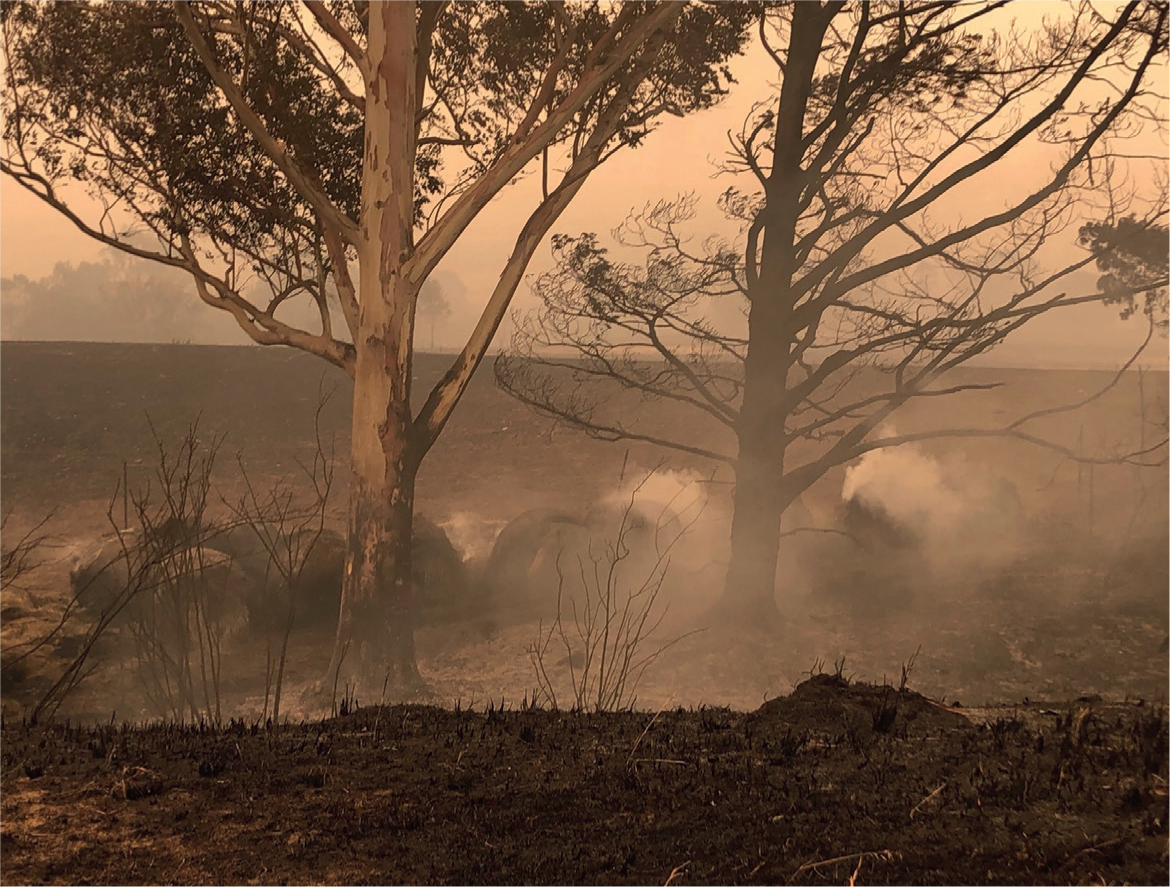
Survival mode
Five days after the Cobargo fire, our attention returned to survival. January 4th was forecast to be a ‘catastrophic’ fire day. Australia has a fire danger rating system that rates the risk of a fire starting — catastrophic is the highest danger rating and predicts that a large and uncontrollable fire is almost certain to occur given the weather conditions. Temperatures of 44°C and 60 km hour winds were predicted. A mandatory evacuation order for Bega was given for all non-residents (i.e. holiday-makers). Locals were warned there were not enough fire-fighting resources to protect smaller towns or individual properties. Thousands of locals moved into the town's main sport ovals and showgrounds with their pets and horses.
The hospital did not have a formal evacuation plan and with a full hospital we needed one. In preparation we transferred the less critical patients to the evacuation centre where a portable hospital was being run by a welfare charity. If the hospital came under threat of fire impact we planned to evacuate with the remaining patients into the centre of town. To avoid last minute panic, we allocated animals to cars and packaged up essential medications and patient records.
Fire impact
The 4th of January never really dawned. The smoke was so thick there was just a hazy orange half-light (Figure 2). It is hard to assess the level of imminent risk when your senses of sight and smell are already saturated with smoke. How do you know when is the right time to leave? By 1 pm the wind was blowing strongly, the smoke was getting thicker and visibility was down to about 100 m. In the end it was an easy decision to evacuate — the fire service pinged our phones with an evacuation order when the fire jumped a nearby highway, and almost simultaneously four fire trucks pulled into the street.
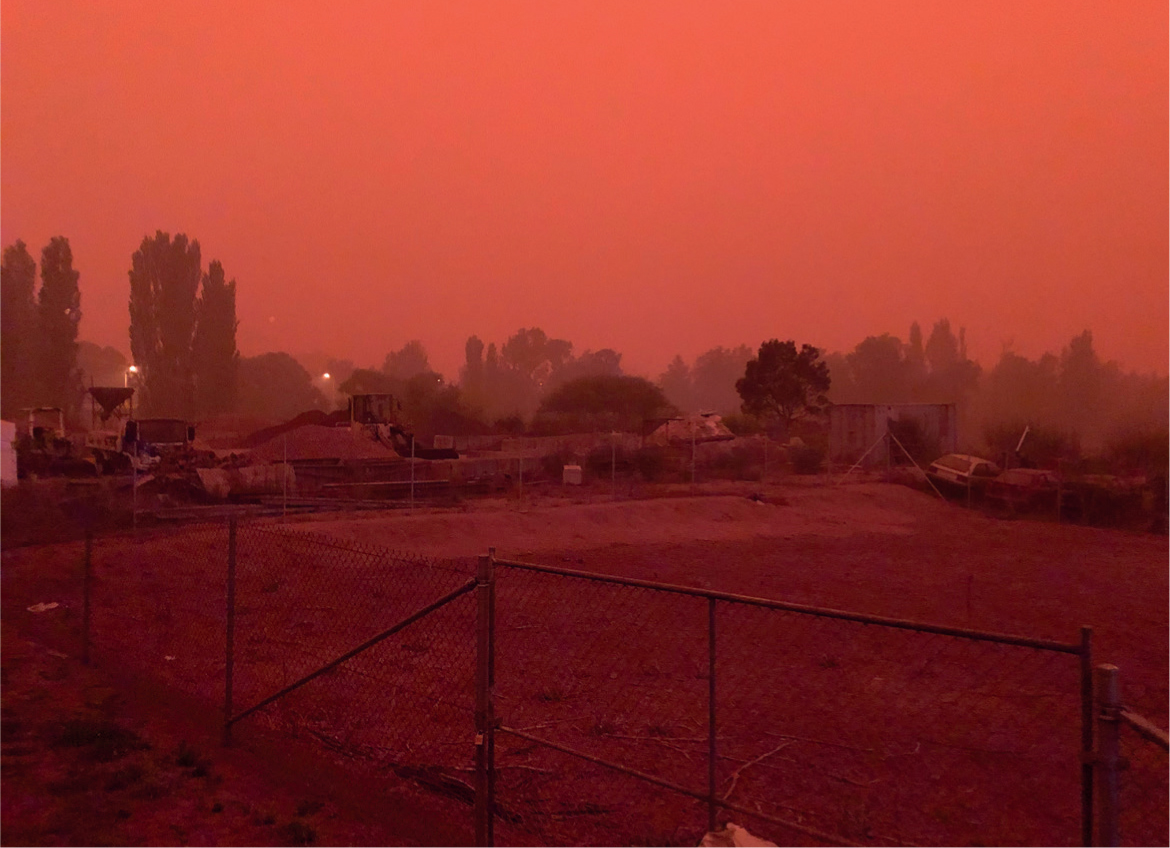
At 3 pm a wind change blew through Bega pushing the blaze back on itself, saving our homes and the veterinary hospital. However, this was not the end: the sky turned red, and then as dark as night as the fires in the south of the Bega Valley tore through thousands of hectares of bushland and decimated small communities. This was a pattern that was repeated many times over the next 5 weeks: a fortuitous wind change for one community spelled disaster for another.
Recovery
The veterinary challenges we faced in the recovery period were obvious, but the business challenges were more difficult to assess. In the short term, financial losses because of hospital closures and evacuations were significant. The presence of animal charities at evacuation centres, while welcome, also reduced income by providing free services and medications unrelated to the fires. Medium-term financial concerns included the possibility of ongoing reduction in farm work and the economic and social impact of the 300+ families in the Bega valley whose houses had been destroyed.
The hospital was engaged in multiple tasks:
- Stock assessment and treatment/euthanasia paired with a government biosecurity officer
- Government-contracted follow-up treatment of burned livestock
- Private small animal burns work
- Pro-bono wildlife burns work (Figure 3)
- Normal day-to-day practice.
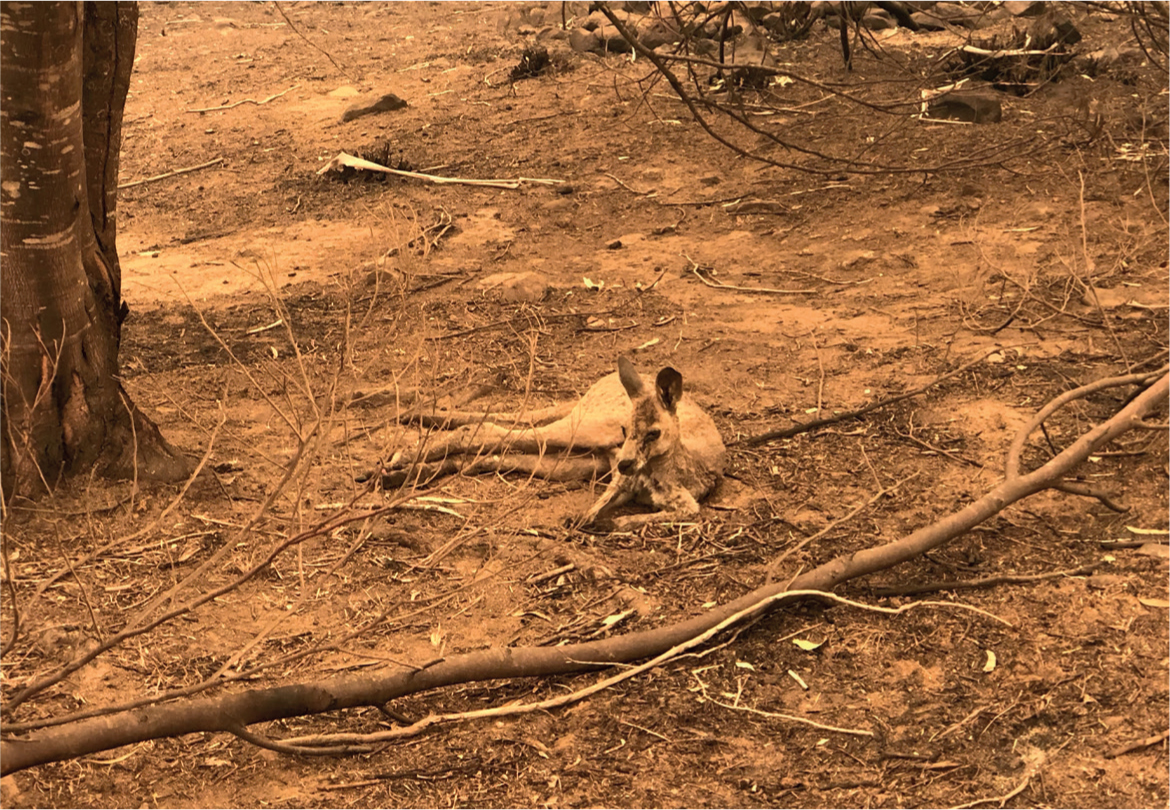
Farm infrastructure was extensively damaged, so close assessment of stock was often a challenge. Animals suffering full thickness burns to >10% of their body were euthanased via firearm at the initial visit, it was a relief to be able to end their suffering. More challenging were the animals that initially did not appear burned but the effects of standing on hot ground eventually lead to lameness and delamination of hooves (Figure 4). Burned udders, prepuces and teats also became more apparent with time, and many more animals were euthanased over the following weeks. Frequent revisits are a vital part of the veterinary assessment process.
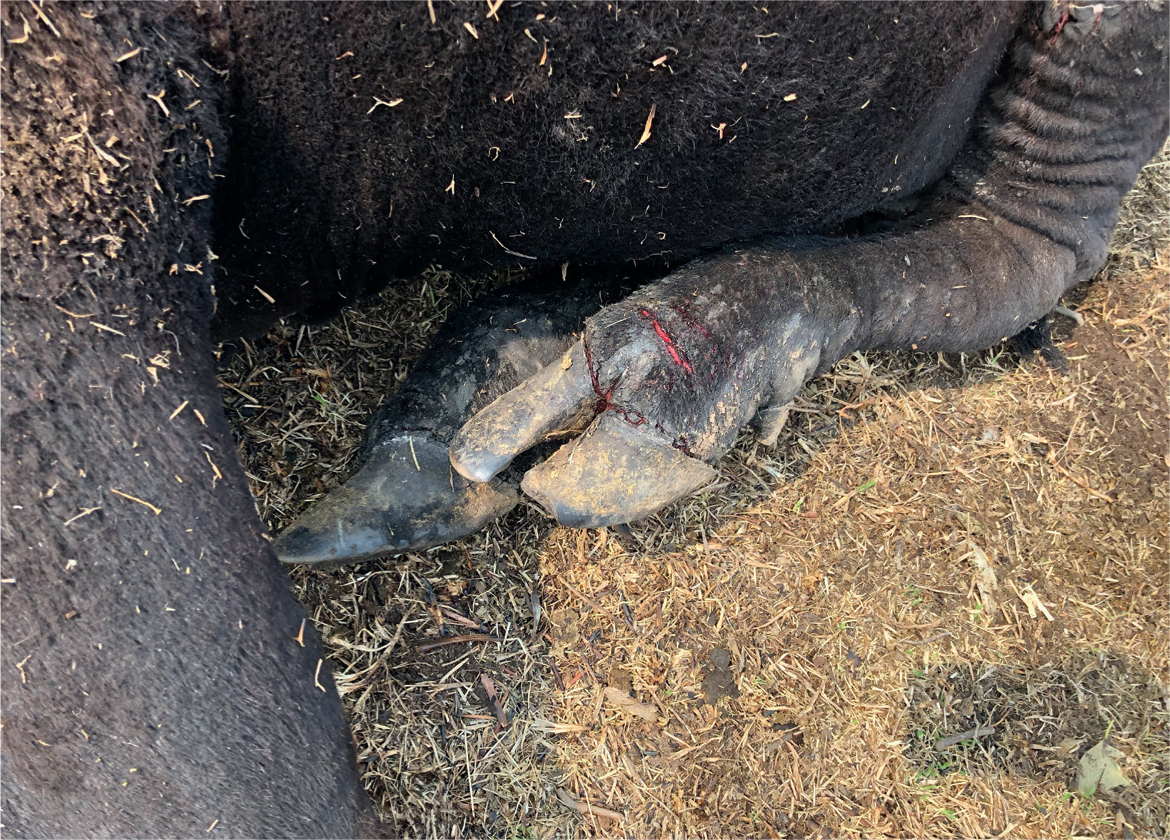
Many of the farmers we visited were deeply traumatised and found the prospect of more death overwhelming. The pre-existing relationships we had with our clients helped facilitate the work of the government biosecurity officers, farmers were universally grateful to have a trusted face as part of the assessment team.
Reflections
Bushfires are a constant threat in rural Australia, the summer of 2019/2020 has taught us that we need to be better prepared as a veterinary community to respond. Formalising the role of private local veterinary practices in the government disaster response as part of preparedness planning, will help private veterinary practices mobilise quickly in a disaster. Coordination between charities responding to emergencies can be improved, to improve efficiency and avoid wasting limited resources.
Lessons from the front line: a veterinary perspective
Veterinarians as a cohort are practiced at operating under pressure and in time critical situations. Frontline emergency service providers train and prepare to operate under the worst case scenario. The average community member, however, does not. As the climate changes, natural disasters will likely impact more people to a greater extent. The solution to mitigating risks posed by a disaster is community (self/family/business) preparedness — so in the face of a disaster there is planned action.
Stress and disaster planning
Experience on the frontline fighting bushfires has shown a wide range of preparedness and response to disasters. Some respond well and follow a prepared plan; others become overwhelmed and make unsafe choices. Acute stress makes it nearly impossible to think critically and rationally — physiology is against us. Research into the effects of acute stress on decision making has shown repeatedly that under stress most people make less advantageous decisions and fail to consider the full range of possible consequences of a decision (Wemm and Edelgard, 2017). Stress can cause a shift from reflective thinking to reactive decision making, particularly when faced with a situation that is unknown (Ogden et al, 2006).
To a degree this shift can be managed with prior experience and extensive training (Khorram-Manesh et al, 2016). Firefighters manage this effect by intensive scenario-based training. The average community member, however, may only experience one disaster in their lifetime. Preparedness planning allows for the process of critical evaluation to be undertaken prior to a disaster event, so in the face of an emergency the plan can simply be enacted.
In Australia, the concepts of disaster planning, preparedness and emergency management have developed rapidly in the last 10 years. This has resulted in improved messaging and available resources. These are easily applied to veterinary practice.
Prevention and preparedness
Disaster planning can be broken into four parts (Box 1). Prevention is about completing a business continuity plan (BCP). A BCP is a plan to restore business services in the event of a disaster. A BCP defines risks that can affect business operations and provides written procedures to ensure effective management of risk during a crisis (Figure 5). Risks include everything from electricity supply through access to work premises. The key to success of a BCP, is testing procedures to ensure they work. A plan that is effective and familiar is more likely to be followed when under stress, this is preparedness.
Bow 1.The basics of disaster planning
- Prevention: complete a business continuity plan, test these procedures and review regularly
- Preparedness: practice the plan regularly
- Response: know when to ‘press go’ — preplanned trigger points
- Recovery: implementation of business continuity plan
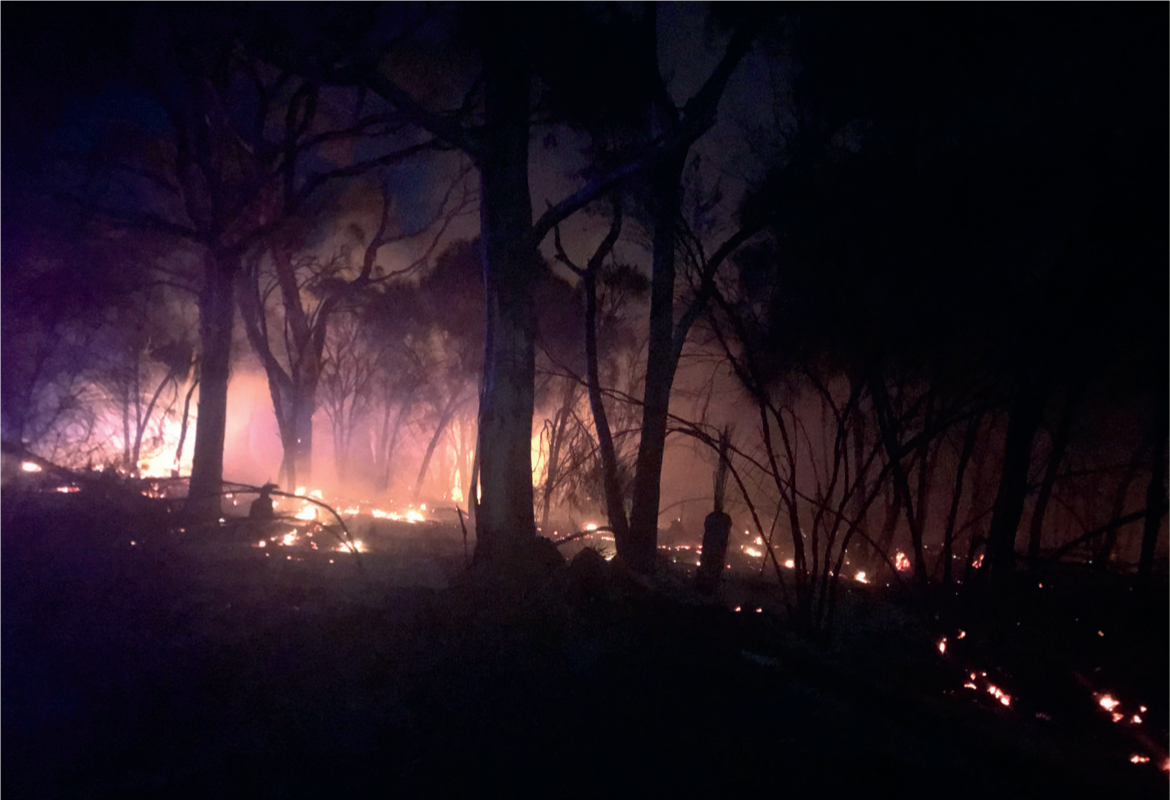
Preparedness also needs to consider how the business will respond in the face of an emergency. In Australia bushfire response plans are considered essential for every person, household and business in risk areas. It is a written plan that outlines the response if a fire occurs nearby — where you will go, how you will get there and what you will take with you. It considers all options, i.e. work day, weekend day — and critically at what point you put your plan into action. The Australian Veterinary Association provides a template for veterinary business bushfire plans.
Response
If the preparedness and planning have been done, the response in the face of a disaster should be relatively straightforward. The main challenge is knowing when to ‘press go’ and enact a plan. Good planning will have identified key triggers that help identify the ‘go point’. In Australia the fire danger index of a particular day is communicated via the media the afternoon before. If the fire danger is extreme or catastrophic (the two highest ratings) this is the trigger for many veterinary businesses to cancel non-emergency appointments in clinic and on farm. This reduces the number of patients that may need to be evacuated and also limits the numbers of veterinary surgeons who may be traveling in risk areas.
Recovery
Good planning makes the recovery step relatively straightforward. The ground work and processes are in place, the BCP just needs to be activated. With experience, we know at this point there are limited resources, limited access and increased levels of mental and physical fatigue (Figure 6).
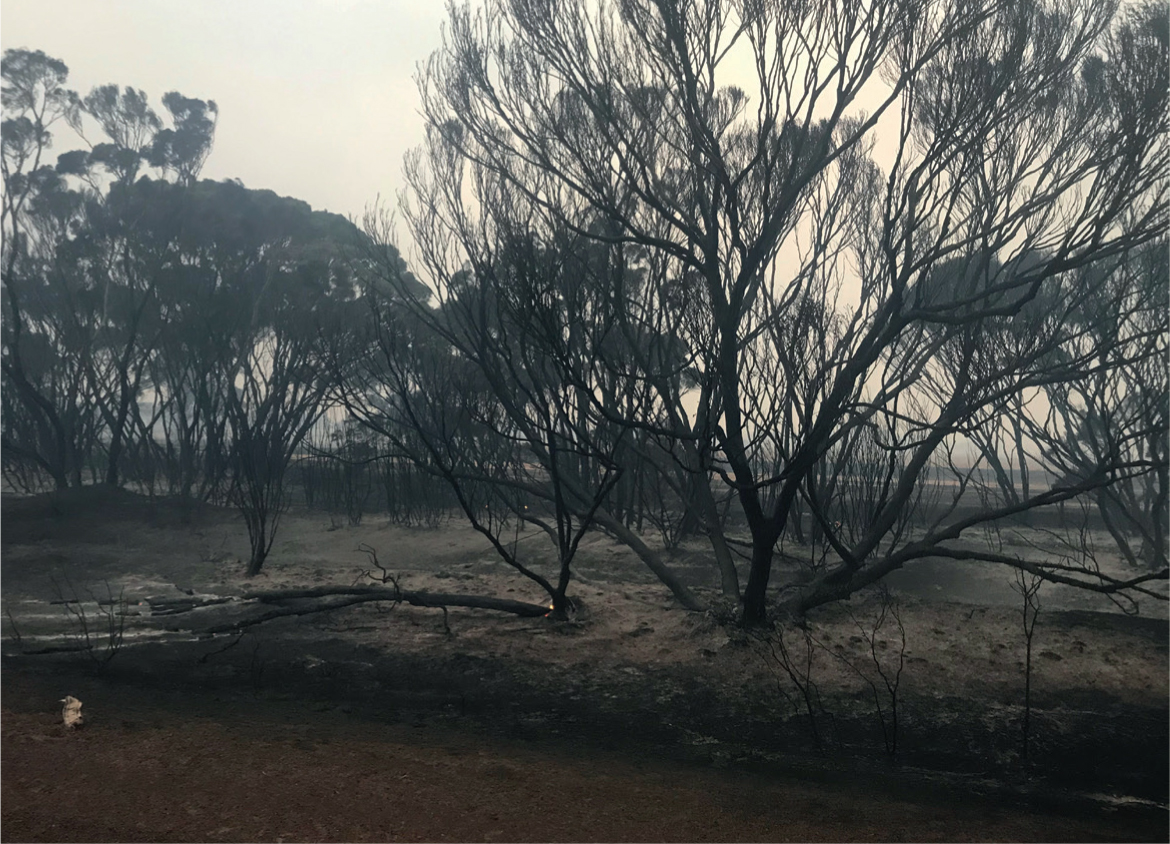
Every large-scale disaster response in Australia and New Zealand is governed by a universal incident management system (Australasian Interagency Incident Management system (AIIMS)). All agencies report in through this system, so activities are aligned, resources are used effectively and importantly the management team know who is in the affected area and what they are doing. Veterinary disaster response teams are now being integrated into the AIIMS system. Team members undergo training so they can operate in these challenging environments safely and effectively and understand how to work within the AIIMS system. It was rewarding to see this integration in action over the summer. Incident management plans clearly outlined what processes firefighters were to follow should they find injured wildlife or livestock — with the assistance of the Australian Defence Force veterinary surgeons were able to be escorted into fire zones. This meant many affected animals were assessed and treated days earlier than previously possible.
Conclusion
One of the major lessons from this disaster is that everyone (individual, household, business, community) has a responsibility for their own safety and their response to an emergency. Prior planning and preparation enables a community level response to an emergency that not only improves outcomes but reduces the burden on emergency services. In a world where natural disasters are becoming the new norm, preparedness is the key to successfully managing these challenges.
KEY POINTS
- A changing climate increases the risk of large-scale natural disasters.
- Everyone has a responsibility to manage their own response to an emergency, there are simply not enough resources to be able to defend every house and every community.
- Prior preparation enables a community level response to an emergency that can improve outcomes in a disaster situation and reduce the burden on emergency services.
- In a world where natural disasters are becoming the new norm, preparedness is the key to successfully managing these challenges.


